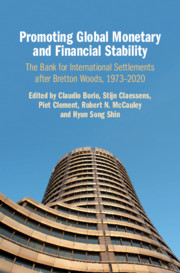 Promoting Global Monetary and Financial Stability
Promoting Global Monetary and Financial Stability Book contents
- Promoting Global Monetary and Financial Stability
- Studies in Macroeconomic History
- Promoting Global Monetary and Financial Stability
- Copyright page
- Contents
- Graphs and Tables
- Contributors
- Foreword
- Acknowledgements
- Abbreviations
- Introduction
- 1 The BIS and the European Monetary Experiment
- 2 The Governance of the Bank for International Settlements, 1973–2020
- The BIS in Pictures, 1973–2020
- 3 A Theory of Everything
- 4 Tower of Contrarian Thinking
- 5 Exchange Rates, Capital Flows and the Financial Cycle
- 6 The Bank for International Settlements
- Book part
- Note on Sources
- Bibliography
- Index
- Other Books in the Series (Continued from p. ii)
3 - A Theory of Everything
A Historically Grounded Understanding of Soft Law and the BIS
Published online by Cambridge University Press: 10 April 2020
- Promoting Global Monetary and Financial Stability
- Studies in Macroeconomic History
- Promoting Global Monetary and Financial Stability
- Copyright page
- Contents
- Graphs and Tables
- Contributors
- Foreword
- Acknowledgements
- Abbreviations
- Introduction
- 1 The BIS and the European Monetary Experiment
- 2 The Governance of the Bank for International Settlements, 1973–2020
- The BIS in Pictures, 1973–2020
- 3 A Theory of Everything
- 4 Tower of Contrarian Thinking
- 5 Exchange Rates, Capital Flows and the Financial Cycle
- 6 The Bank for International Settlements
- Book part
- Note on Sources
- Bibliography
- Index
- Other Books in the Series (Continued from p. ii)
Summary
This chapter provides an historical account of why the institutional setting of the BIS has been conducive to the emergence of soft law as a critical tool for managing the global financial system. Soft law developed almost naturally at the BIS as a result of the many technocratic issues it was called on to deal with throughout its long history – be it German reparation payments in the 1930s, the management of the Bretton Woods system of fixed exchange rates in the 1960s or growing financial stability concerns in the 1970s and 1980s and beyond. The Basel I Capital Accord, adopted in 1988, was a political and regulatory watershed in that respect – a non-binding code of conduct agreed by an informal committee of experts (the Basel Committee on Banking Supervision), that was subsequently implemented by national legislation in all the main constituencies. The chapter argues that the relative success of soft law in financial regulation owes a lot to the particular set-up and traditions of the BIS. However, it concludes that in order to be successful in future, soft law – much like the BIS – will have to become ever more inclusive and transparent.
Keywords
- Type
- Chapter
- Information
- Promoting Global Monetary and Financial StabilityThe Bank for International Settlements after Bretton Woods, 1973–2020, pp. 112 - 133Publisher: Cambridge University PressPrint publication year: 2020
- 1
- Cited by
